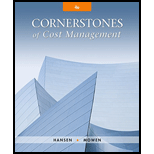
1.
Calculate the velocity and theoretical cycle time that takes to produce one model
1.
Explanation of Solution
Cycle time: Cycle time and velocity are two operational “measures of responsiveness”. Cycle time is the span of time taken to produce a unit of output from the time the materials are received till the good is supplied to finished goods inventory. Therefore, cycle time is the time taken to produce a product.
Velocity: Velocity is the number of units of output that can be produced within a given period of time.
Calculate the theoretical velocity:
Calculate theoretical cycle time:
2.
Calculate the actual velocity and the actual cycle time.
2.
Explanation of Solution
Calculate the actual velocity:
Calculate actual cycle time:
3.
Calculate the manufacturing efficiency cycle and comment on the efficiency of the operation.
3.
Explanation of Solution
Manufacturing efficiency ratio: Manufacturing efficiency ratio is a measure of Just-In-Time (JIT) manufacturing system and it expresses the time spent in value-added activities as a percentage of total cycle time.
Calculate Manufacturing cycle efficiency:
Therefore, from the above calculation, it is noted that, the “efficiency of the operation” is very high.
4.
Compute the budgeted conversion cost per minute, compute the conversion cost per model, compute the conversion cost per model for actual output and explain whether the product costing approach provide an incentive for the cell manager to reduce cycle time.
4.
Explanation of Solution
Calculate budgeted conversion cost:
Calculate theoretical conversion cost per model:
Calculate actual conversion cost per model:
Yes, the cost per unit can be decreased by decreasing cycle time. The potential reduction is $48 (1) per model.
Working note:
(1)Calculate the potential reduction:
Want to see more full solutions like this?
Chapter 13 Solutions
Cornerstones of Cost Management (Cornerstones Series)
- What is the total period cost for the month under variable costing?arrow_forwardPlease provide the correct answer to this general accounting problem using accurate calculations.arrow_forwardAlbert Crafts produces two types of handmade candles: Standard and Luxury. The Standard candle sells for $12 with variable costs of $8 per unit, while the Luxury candle sells for $25 with variable costs of $15 per unit. Albert Crafts maintains a sales mix ratio of 70% Standard and 30% Luxury candles. Monthly fixed costs total $42,000. How many total candles (of both types combined) must Albert Crafts sell to break even?helparrow_forward
- Please help me solve this financial accounting problem with the correct financial process.arrow_forwardCameron Manufacturing's break-even point in sales is $1,875,000, and its variable expenses are 65% of sales. If the company lost $84,000 last year, what must have been the total sales?arrow_forwardOn May 1, Fair wind Chemicals Inc. issued a $120,000, 9%, 6-month note payable. Interest is payable at maturity. What is the amount of interest expense that should be recorded in a year-end adjusting entry if the fiscal year-end is: A) October 31? B) June 30?arrow_forward
 Cornerstones of Cost Management (Cornerstones Ser...AccountingISBN:9781305970663Author:Don R. Hansen, Maryanne M. MowenPublisher:Cengage Learning
Cornerstones of Cost Management (Cornerstones Ser...AccountingISBN:9781305970663Author:Don R. Hansen, Maryanne M. MowenPublisher:Cengage Learning Managerial Accounting: The Cornerstone of Busines...AccountingISBN:9781337115773Author:Maryanne M. Mowen, Don R. Hansen, Dan L. HeitgerPublisher:Cengage Learning
Managerial Accounting: The Cornerstone of Busines...AccountingISBN:9781337115773Author:Maryanne M. Mowen, Don R. Hansen, Dan L. HeitgerPublisher:Cengage Learning

